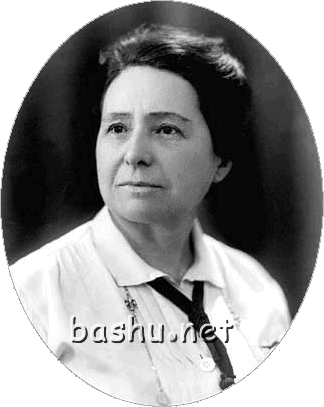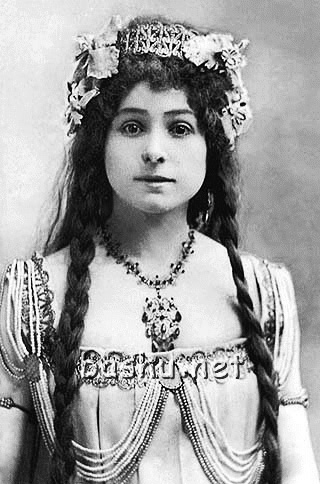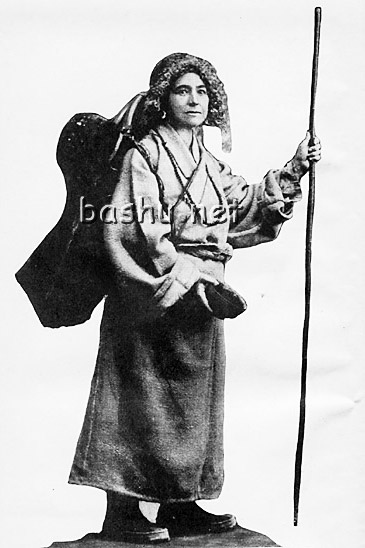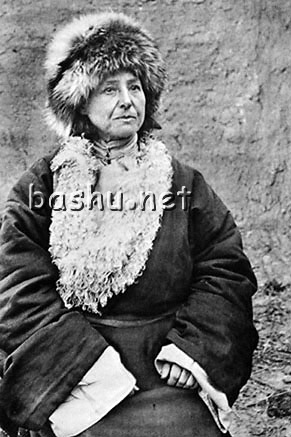| People | ||||||
Alexandra David-Néel (1868-10-24--1969-9-8) Alexandra David-N¨Ĥel, Mystic, occultist and traveller,  Alexandra David was born in Paris, on the 24th of October 1868. As a child her favourite books were the science fiction fantasies of Jules Verne, and she promised herself one day to outdo the heroes of these stories. One of the first indications of this sense of adventure was her running away just before the family left to move to Brussels. Only after a widespread search was she caught by a gendarme, whom she scratched for his trouble. Alexandra David was born in Paris, on the 24th of October 1868. As a child her favourite books were the science fiction fantasies of Jules Verne, and she promised herself one day to outdo the heroes of these stories. One of the first indications of this sense of adventure was her running away just before the family left to move to Brussels. Only after a widespread search was she caught by a gendarme, whom she scratched for his trouble.By the age of fifteen Alexandra had already begun to study music, at this time she also obtained her first occult reading matter, an English journal produced by the Society of the Supreme Gnosis, sent to her by a woman called Elisabeth Morgan. That summer her family spent the holidays in Ostend, but Alexandra wanted something more interesting and walked into Holland and crossed over to England. In London she found Mrs. Morgan, who immediately persuaded her to return home. In 1885, when she was seventeen, Alexandra again left home. This time she hiked alone over the Saint-Gotthard Pass through the Alps to the Italian lakes. Her mother came and retrieved her at Milan. London & the Theosophical Society The following year she entered the Royal Conservatory of Brussels, and three years later won first prize for her soprano voice. In 1888 she went to study in London, and stayed cheaply and securely at the Society of Supreme Gnosis. Here, Elisabeth Morgan introduced her to Madame Blavatsky, the founder of the Theosophical Society, whose esoteric ideas had a significant influence on Alexandra. Alexandra returned to Brussels the next year to carry on her studies of music and voice. In her early twenties she studied at the Sorbonne and became a political radical, keeping a pistol and ammunition in her Paris room. In 1891, when she was twenty-three, disguised as a man, she joined a Paris cult led by Sri Ananda Saraswati, who used hashish to obtain visions. That same year she travelled for more than a year through Ceylon and India. At Adyar, near Madras, she joined the Theosophists under Annie Besant, and studied Sanskrit with them. At the holy city of Benares, on the Ganges, she studied yoga with the great Swami Bhaskarananda (of Varanasi), who lived the whole year in a rose garden. She was fascinated by India and the Tibetan music she heard there, but was forced to return to Brussels when she ran out of money. From 1894 to 1900 she lived as an aspiring actress/singer, but by 1900 her career was going nowhere and she accepted a job with the municipal opera in Tunis. Here she met Philip Neel, a thirty-nine-year-old bachelor who worked as a railway engineer. They married on 4th August, 1904, and took a villa at La Goulette next to the Mediterranean Sea. Sanskrit Studies in India In 1911 she undertook her second voyage to India, and arrived at Pondicherry - all that remained of French India - where the police kept an eye on her due to her extremist tendencies. By 1912 Alexandra was living in Calcutta, where on one occasion, annoyed by the behaviour of fakirs, she lay down on a bed of nails, and explained to a passing British tourist that she needed a rest and was lucky to find a bed. She also took part in Tantric rites, on one occasion the ritual of the so-called 'five forbidden substances': meat, fish, grain, wine, and sexual union. She was progressing quickly with her Sanskrit studies, and was so noted a figure at holy Benares as to be honoured by the College of Sanskrit there with an honorary doctorate of philosophy, a first for a European woman. When she arrived in the small Himalayan state of Sikkim, in 1912, she immediately felt at home, and increased her knowledge of Buddhism by visiting all the important monasteries there. She also met Prince Sidkeong of Sikkim. It was here that she became the first European woman to meet the Dalai Lama, at the time in exile. He told her to learn the Tibetan language. She made great progress in this and met the Gomchen (great hermit) of the monastery of Lachen. He was an impressive figure wearing a five-sided crown, a rosary necklace of 108 pieces of human skull, an apron carved of human bone, and a magic dagger. During the next two years Alexandra met with the hermit and learnt the art of telepathy from him. She also attempted 'tumo' breathing, the Tibetan art of generating body heat to keep warm in freezing conditions. Two years later she met a young man called Aphur Yongden, and a friendship which was to last a lifetime developed between them; he eventually became her adopted son. They both moved to a cave hermitage in northern Sikkim, close to the border with Tibet, which it was forbidden to cross into. Tibet was rarely visited by Europeans at that time, let alone European women. Nevertheless Alexandra and Yongden did so twice, the result being expulsion from Sikkim in 1916. Because of the war it was impossible to return to Europe, so they travelled to Japan. In a letter to her husband at the time Alexandra confessed to being 'haunted by the steppes, the solitude, the everlasting snow and the great blue sky '. From Japan they travelled on to Korea, then had an extremely difficult journey across the entire width of China, then the Gobi desert and Mongolia. They were attacked by bandits on the way to the monastery of Kum Bum, where they were to spend three years deep in study.  Alexandra David-N¨Ĥel The Creation of a Tulpa At Kum Bum she managed to create a 'tulpa', a phantom produced by intense concentration of thought and the repetition of relevant mystical rites over a period of months. She created a stout, phantom monk, whose form gradually became less ghost like and more life like. Before long the phantasm was accompanying her on her travels and behaving almost like a normal human being. However, he gradually began to change from a fat, jolly monk into a leaner more sinister character, and started to escape from her control. The tulpa was seen by others in her travelling party, proving it to have an objective existence outside of Alexandra's own mind, but, to avoid serious problems with her creation, Alexandra decided to 'dissolve' it. But this proved extremely difficult as the phantom clung desperately on to his life; she only succeeded in getting rid of him after six months of hard mental concentration.  Alexandra David-Neel, 1927l Tibet acts very much as a magnet to many of those who seek spiritual guidance. Pilgrims and travelers have visited the holy land of central Asia from all over the world. The image here is of Alexandra David-Neel, of France, in a typical Tibetan travel outfit, including the alms bowl. The Strange Journey to Lhasa Soon after this, in February 1921, Alexandra and Yongden left all their belongings and, disguised as beggars, set off on their journey to forbidden Tibet, and the holy city of Lhasa. The journey was to last an epic three years, and the details are recounted in Alexandra's book My Journey to Lhasa, first published in English in 1927. The route, as the crow flies, was 3,900 miles, but Alexandra's expedition was a different matter. She was twice intercepted and often had to change her plans. At one stage, in early 1923, she went as far north as the Gobi Desert, from where she returned via Kanchow and Lanchow, south through China, and westwards into southern Tibet. Altogether her journey covered around 8,000 miles on horse, sedan chair and foot. Along the way bandits were a menace, as were tigers and leopards. On the journey they met a strange phenomenon known as a 'lung-gom' runner. First seen as a distant moving black spot, this rapidly changed into a man running towards them at an incredible speed. Alexandra was warned not to stop the speeding lama or it would kill him. When she looked closely at him she could see that he his expression was extremely relaxed and staring fixedly at an imaginary far away object. His steps were as regular as a pendulum, though he didn't seem to run but progressed by great leaps like a bouncing rubber ball. He held a magic dagger in his right hand which he seemed to be using as a staff, though it was high off the ground. Apparently, such runners would carry on this amazing feat for days without stopping for food or water. Alexandra was told that years of meditation were required before undertaking this feat. In February 1924, Alexandra and Yongden eventually arrived in the territory of Lhasa. Here they remained for two months, before leaving as quietly and unobtrusively as they had entered. Returns to France Alexandra returned home to France in 1925, and was a huge success in Paris. After separating from Philip she settled in Digne, Provence, in 1928, and built 'Samten-Dzong', which she called her 'fortress of meditation'. She published many books about her travels from here and also went on lecture tours throughout Europe. In 1937, at the age of 70, she set off for China via the Trans-Siberian railway, arriving there during the violent war with Japan. She wrote and studied despite the conditions and went on to India in 1946. She returned to France and settled once again at Digne. In 1955 Yongden died. Alexandra worked constantly and had her passport renewed at the age of 100, much to the surprise of the officials at the passport office. She was awarded a gold medal by the Geographical society of Paris and in 1969 was made a Knight of the Legion of Honour. In addition, in Tibet, she was granted the rank of lama. She died on 8th September, 1969. On the 28th February 1973, her ashes with those of her adopted son, Lama Yongden, were scattered over the waters of the Ganges at the holy city of Benares.  Alexandra David-N¨Ĥel Sources and Further Reading Foster, Barbara and Michael. The Secret Lives of Alexandra David-Neel. New York, The Overlook Press, 1998. David-Neel, Alexandra. Magic and Mystery in Tibet. New York, Dover Publications Inc.,1971 (1932). Gordon, S. The Paranormal. An Illustrated Encyclopedia. London, Headline, 1992, pp 162-3.
| ||||||
| Best View:IE 7.0, 1024x768 | Update:2008-04-19 |